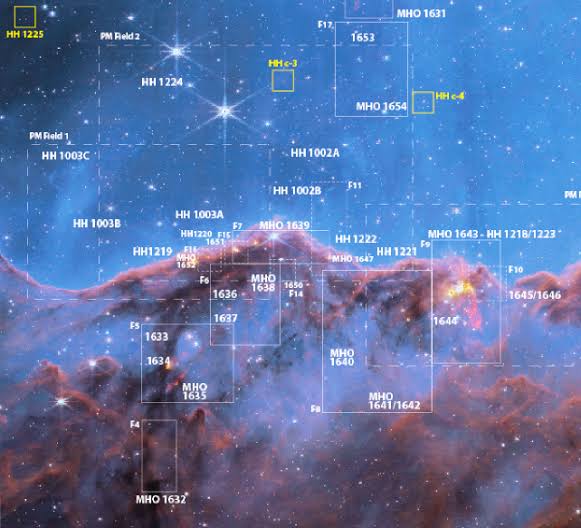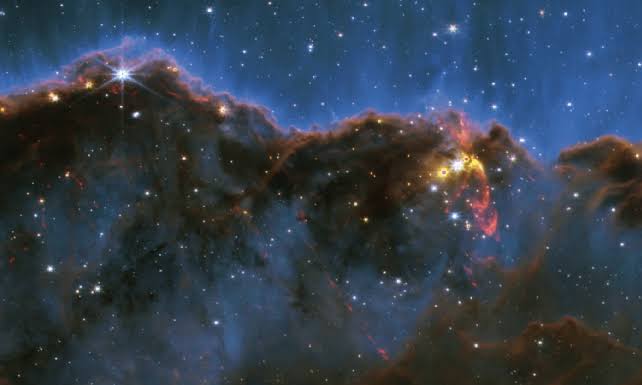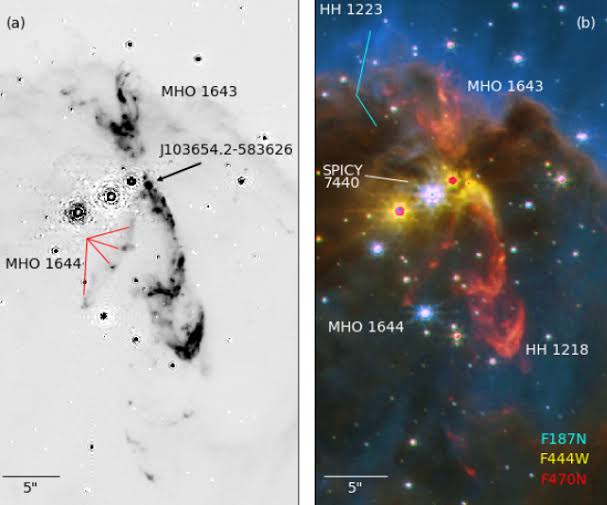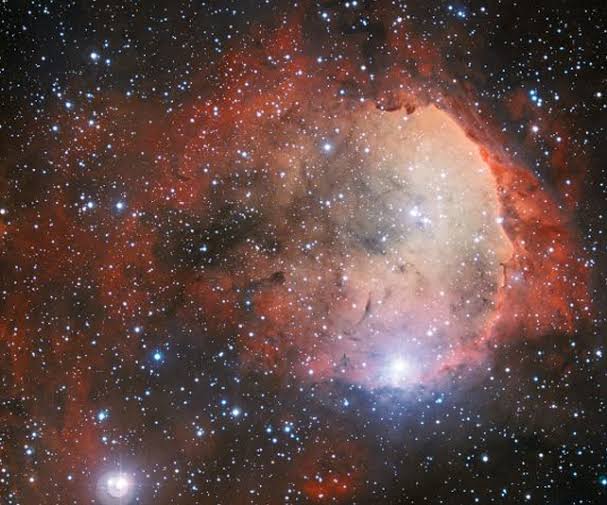The robust James Webb Space Telescope is an impressive piece of technology. It was initially imagined by astronomers more than 20 years ago, and on December 25, 2021, it was launched after taking several detours. It’s currently in a halo orbit near the Sun-Earth L2 point, where it should be able to function for another 20 years.
Only a few months have passed since its initial photographs were made public, but it has already made strides toward resolving some of the most intriguing mysteries of the universe.
Something Appeared In One Of The Photos Taken By JWST
The JWST observed the birth of nascent stars in their stellar cocoons in a recently released image as it peered deep inside enormous clouds of gas and dust.
The “Cosmic Cliffs” appeared in one of the first photographs taken by JWST. The Cosmic Cliffs are the boundary of a star-formation zone that is actively creating stars in NGC 3324, a star cluster close to the Carina Nebula.
The image depicts the region’s extreme ultraviolet radiation from bright young stars, which carves out ominous gaps and leaves towers of gas that block the radiation.
What Made The Researchers Amazed
Back in July, we were all awestruck by that image, but now researchers are delving into it to discover more about the region and the star-forming activities taking place there. A report outlining the findings of their work was published in the Monthly Notices of the Royal Astronomical Society (MNRAS).
Its title is “Deep diving off the ‘Cosmic Cliffs’: Outflows in NGC 3324 previously hidden but revealed by JWST.” Megan Reiter, an astrophysicist at Rice University in Houston, Texas, is the lead author.
More than two dozen previously undetected outflows from hot, young stars were discovered when the Researchers extensively analyzed the Webb image.
What does the press say?
A press statement describing the findings stated that the findings ranged from “small fountains to burbling behemoths.” The distance of some of the outflows from their stars is many light-years.
What Webb gives us is a moment?
That allows us to observe how much star formation is occurring in what may be a more typical area of the universe than we have been able to observe before, according to Reiter.
What Made The Research Possible?
The research was made possible by the robust infrared capabilities of the JWST. It may concentrate on molecular hydrogen, the primary constituent of stars.
This is because young stars absorb the hydrogen as they develop and release some of it in jets and polar outflows. It makes a fantastic tracer for star-forming activity. These jets create caves in the picture’s gas and dust clouds through a process known as stellar feedback.
What Are The Main Scientific Goals?
The dense molecular clouds that give rise to them block our view of young, still-forming protostars. However, these clouds may be seen inside by the JWST. One of the telescope’s four main scientific goals is to examine the young stars that are hidden inside the clouds.
Long before Webb was finished and put into operation, a NASA webpage stated that it would be “able to peer right through and into huge clouds of dust that are opaque to visible-light telescopes like Hubble, where stars and planetary systems are being created.” All of those predictions are now being fulfilled.
Co-author Tell Us Precisely
“These kinds of Jets Serve as markers for the most thrilling stage of star formation. Only for a brief period of time while the protostar is actively accreting do we observe them “Co-author Nathan Smith of the University of Arizona in Tucson explained the situation.
Astronomers continue to discover more about how other newborn stars form, which helps them understand how our own Sun formed and how our Solar System came to be. Our knowledge of the intricate dynamics underlying their development is expanding and strengthening thanks to the JWST.

Investigator’s Report
Reiter continued, “It opens the door for what will be feasible in terms of looking at these groups of young stars in very typical cosmological conditions that were unseen before the James Webb Space Telescope.
“Now that we know where to look next, we can investigate the factors that are crucial for the development of Sun-like stars.”
This is because they occur within a dense envelope of gas and only endure for a short time, the outflow jets in the early phases of star formation are difficult to witness. The jets have a limited lifespan of a few thousand years, possibly ten thousand.
Analysis Done By The Team
The jets can only be seen when you take a deep dive and analyze each area separately, according to The team member Jon Morse of the California Institute of Technology, Pasadena. “In the image first released in July, you see hints of this activity, but these jets are only visible when you embark on that deep dive,” he said.
Like unearthing hidden treasure, one of the main goals of modern astrophysics is to understand how newborn stars develop. The first stars’ combined light contributed to the early Universe’s reionization.

A thick layer of primordial gas covered the Universe before the Epoch of Reionization. Young stars’ light helped to remove the Universe’s veil during Reionization and made it possible for light to travel.
Key Scientific Goals Of The JWST
One of the Key Scientific Goals Of The JWST is to answer the question of how these earliest stars evolved because astrophysicists do not yet know the answer. However, The JWST is unable to distinguish between individual stars. JWST can see objects that have been strongly redshifted from the early Universe.
These recently published pictures are crucial because of this. Astrophysicists may observe newborn stars forming now and progress toward a more complete knowledge of the Epoch of Reionization, even though they cannot examine the development of the very earliest stars.

This isn’t the first time scientists have looked at the development of newborn stars in this region. It was observed by Hubble 16 years ago.
Sufficient Intel
Even though the Hubble cannot see as much detail as the James Webb, it provided enough information for the study’s authors to compare how the jets and outflows have altered over time.
What Does The Data Reveal ?
The Data reveal the jets’ motional velocities and directions, crucial information for comprehending newborn stars.
The JWST’s investigation into star formation has only begun with these Early Release Images (ERO).The scientists state that “future observations will enable quantitative measurement of the excitation, mass-loss rates, and velocities of these new flows.”
A Glimpse Of Star Formation
The region of massive star formation NGC 3324 “offers a glimpse of what Star Formation investigations with JWST may yield” as it is a very small area of star creation.
Future observations will be in-depth and specific. They’ll contribute to furthering our understanding of one of the most hotly debated subjects in astronomy: how young stars influence planetary formation.

The Five Ages Of The Universe
The book “The Five Ages Of The Universe” says that we are in the “Stelliferous Era” of the universe. Matter in this age is predominantly organized into stars, galaxies, and galactic clusters. The majority of the energy in the universe is and will continue to be produced by stars. Since stars are the source of life’s energy, the Stelliferous Era may easily be referred to as the Age of Life.
The Sun is identical to other stars. The Sun would have produced the same outflows and polar jets as the young stars in this figure although the same factors drove its creation and evolution. The protoplanetary disc in which the Earth formed would have been influenced by those feedback mechanisms.
Conclusion
We gain new knowledge about our origins every time we glimpse pictures of young stars in other places. It’s a blessing that the James Webb Space Telescope can show us these beautiful, expansive vistas of star formation. The mind travels with the eye due to the stunning, amazing details. We can sit and ponder whether life or possibly another civilization might emerge around each one.
